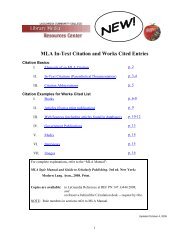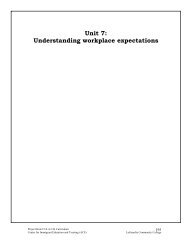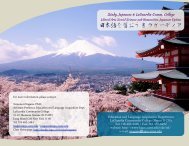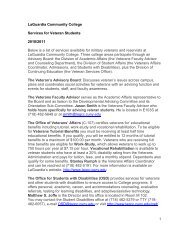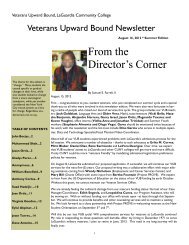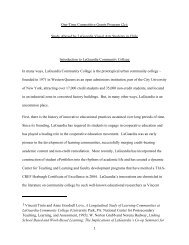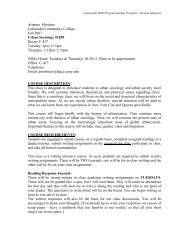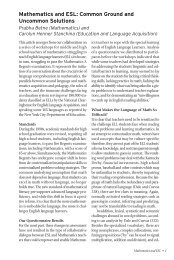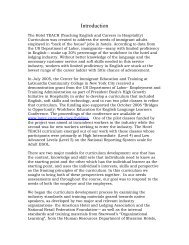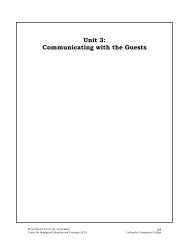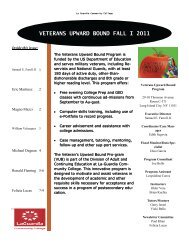Human anatomy and physiology i - LaGuardia Community College
Human anatomy and physiology i - LaGuardia Community College
Human anatomy and physiology i - LaGuardia Community College
You also want an ePaper? Increase the reach of your titles
YUMPU automatically turns print PDFs into web optimized ePapers that Google loves.
HUMAN ANATOMY AND<br />
PHYSIOLOGY I<br />
SCB203<br />
<strong>LaGuardia</strong> <strong>Community</strong> <strong>College</strong><br />
Dept. of Natural Sciences<br />
Dr. Carol Haspel, Coordinator<br />
Revised 3/2011<br />
1
Policy on Cheating<br />
Instructors of this course are required to implement <strong>College</strong> policy regarding<br />
cheating on examination <strong>and</strong> quizzes. A complete statement is available through<br />
student counseling services.<br />
A synopsis is as follows:<br />
If an instructor suspects a student of cheating, of any of the violations<br />
listed below, the instructor will inform the student of his or her suspicion, <strong>and</strong> a<br />
student/-teacher conference will be held. At that conference, the suspected<br />
violation <strong>and</strong> the instructor’s intended penalty for the violation will be discussed.<br />
1. Give the student a copy of the STUDENT HANDOUT ON LAGUARDIA<br />
ACADEMIC INTEGRITY POLICY (this document) <strong>and</strong> answer any<br />
questions the student may have.<br />
2. Inform the student of the reasons for your suspicions <strong>and</strong> the intended<br />
penalties. These penalties may include, but are not limited to, the<br />
following:<br />
a. An “F” on the paper, quiz, assignment or examination involved:<br />
b. An “F” for the course.<br />
3. If the student admits guilt, <strong>and</strong> agrees on the penalty, he/she should<br />
indicate so on the formal complaint. The instructor will then send the<br />
complaint to the Office of Academic St<strong>and</strong>ing <strong>and</strong> impose the penalty.<br />
4. If the student does not admit guild or agree to the penalty, the<br />
student/teacher conference will end, <strong>and</strong> a hearing on the issue must be<br />
held. The instructor will then submit the complaint to the Office of<br />
Academic St<strong>and</strong>ing, which will send a copy to the Dean of Students, who<br />
will then begin disciplinary proceedings.<br />
If the records of the Office of Academic St<strong>and</strong>ing indicate that the student<br />
has committed a similar offense, the Office of Academic St<strong>and</strong>ing will:<br />
Send a copy of the complaint to the Dean of Students, who will begin<br />
disciplinary proceedings.<br />
2
HUMAN ANATOMY AND PHYSIOLOGY I<br />
GRADING PROCEDURES AND CRITERIA<br />
The final grade for <strong>Human</strong> Biology is calculated from both lecture <strong>and</strong> laboratory<br />
examination grades; 60% of the final grade is determine from the lecture exams<br />
<strong>and</strong> 40% from the lab exams.<br />
Lecture Exams<br />
% of the Final Grade<br />
6 Lecture Quizzes (of which the lowest 30%<br />
grade may be dropped at the<br />
instructor’s discretion)<br />
1 Midterm Exam 15%<br />
1 Final Exam 15%<br />
60%<br />
Laboratory Exams<br />
% of the Final Grade<br />
2 Practical Exams 20%<br />
1 Written Exam 10%<br />
1 Written Exam with practical component 10%<br />
40%<br />
Practical exams will be based on identification of actual laboratory materials<br />
displayed at stations. Written exams will include short answers, fill-ins, diagrams,<br />
<strong>and</strong> short essays. Attendance is compulsory for all labs. It will be the student’s<br />
responsibility to make-up any missed labs. No make-up exams are given in<br />
laboratory.<br />
Final Grades<br />
92.5-100 = A<br />
89.5-92.4 = A-<br />
86.5-89.4 = B+<br />
82.5-86.4 = B<br />
79.5-82.4 = B-<br />
76.5-79.4 = C+<br />
72.5-76.4 = C<br />
69.5-72.4 = C-<br />
66.5-69.4 = D+<br />
62.5-66.4 = D<br />
59.5-62.4 = D-<br />
0-59.4 = F<br />
CHEATING WILL RESULT IN FAILURE<br />
3
SCB 203/204 INFORMATION SHEET<br />
Attendance <strong>and</strong> punctuality are necessary for success; absence or lateness<br />
exceeding 10% is considered excessive. Classes will meet in accordance to the<br />
Academic Calendar (be sure to get a copy from the Information Desk in the Main<br />
Building) unless otherwise specified. Severe weather does not cancel classes;<br />
listen to your radio/TV for <strong>College</strong> closings.<br />
Student rights <strong>and</strong> responsibilities can be found in the <strong>College</strong> H<strong>and</strong>book <strong>and</strong><br />
Catalog, please refer to them.<br />
The Grading Policy for these courses can be found on page 3 of your course<br />
outline. Repeat, “R”, grades are not given in this course <strong>and</strong> Incompletes, “IN”,<br />
are issued only under very restricted circumstances. In order to receive an<br />
Incomplete, a student must have PASSING GRADES <strong>and</strong> be able to document<br />
why he/she is unable to complete the course work during the semester. Both the<br />
student <strong>and</strong> the instructor must complete <strong>and</strong> sign an Incomplete Form <strong>and</strong> list<br />
the exams that must be satisfactorily completed before a grade is issued.<br />
Students have 6 months to take the missing exams; otherwise the Incomplete is<br />
automatically converted to an F. An Incomplete does not provide a student with<br />
an opportunity to retake an exam(s); all prior grades are retained <strong>and</strong> added into<br />
the calculation of the final grade.<br />
4
LAGUARDIA COMMUNITY COLLEGE<br />
CITY UNIVERSITY OF NEW YORK<br />
SCB203: HUMAN ANATOMY AND PHYSIOLOGY I<br />
TEXT: Anatomy & Physiology, 6 th edition by Kenneth Saladin, ISBN: 0077508211<br />
SYLLABUS<br />
LECTURE TOPIC (S) READING<br />
1. Outline of <strong>Human</strong> Biology Ch. 1 (pg. 2-3, 12-19,<br />
37-39)<br />
2. Introduction to Chemistry Ch. 2<br />
3. Reactions <strong>and</strong> Ionic Bonding Appendix A (pg. A1)<br />
4. Covalent <strong>and</strong> Hydrogen Bonding<br />
5. Acids, Bases, <strong>and</strong> Salts<br />
6. LECT. QUIZ 1 Introduction to Biochemistry<br />
7. Lipids <strong>and</strong> Proteins<br />
8. Nucleic acids & Heredity Appendix A (pg. A1)<br />
9. Protein Synthesis pg. 121-126<br />
10. The Cell Ch. 3<br />
11. Cell Physiology pg. 126-129<br />
12. LECT. QUIZ 2 Tissue – Epithelial Ch. 5<br />
13. Tissue-Connective, <strong>and</strong> organs<br />
14. Integumentary System-Introduction Ch. 6<br />
15. Skin Derivatives <strong>and</strong> Pathology<br />
16. LECT. QUIZ 3 Skeletal Organization Ch. 7<br />
17. Skeletal Physiology & Joints Ch. 9<br />
18. MIDTERM EXAM (will test Chap 1-3, 5-7, 9 + additional pages)<br />
19. Muscular Organization Ch. 11 + Pg. 164-165,<br />
313-317<br />
20. Myo<strong>physiology</strong> <strong>and</strong> neural control<br />
21. Muscles <strong>and</strong> Body Movements pg. 318-319, 284-288,<br />
501-502<br />
22. Myopathology<br />
23. LECT. QUIZ 4 Blood-components <strong>and</strong> Functions Ch. 18<br />
24. Blood Types <strong>and</strong> Clotting<br />
25. Blood Pathology<br />
26. Cardiology Ch. 19<br />
27. Control of Cardiac Function & Cardiopathology<br />
28. LECT. QUIZ 5 Circulation Ch. 20 (pg. 750-773,<br />
800-802)<br />
29. Circulatory Physiology pg. 790-791 + 1115<br />
30. Structure <strong>and</strong> Mechanics of Respiration Ch. 22 + Pg. 593-94<br />
31. Physiology <strong>and</strong> Chemistry of Respiration<br />
32. Regulation of Respiration <strong>and</strong> Disorders<br />
33. LECT. QUIZ 6 Lymphatics Ch. 21<br />
34. Immunity<br />
35. Immunity continued<br />
36. Review<br />
FINAL EXAMINATION GIVEN DURING EXAM WEEK<br />
(Chapter 11, 18-22 will be tested plus additional designated pages)<br />
5
Lecture 1: Outline of <strong>Human</strong> Biology<br />
SCB 203 – HUMAN ANATOMY AND PHYSIOLOGY I<br />
LECTURE OUTLINE<br />
A general discussion of the principles of human <strong>physiology</strong>.<br />
Objectives:<br />
a. Define <strong>physiology</strong>, cytology, <strong>anatomy</strong>, histology <strong>and</strong> pathology.<br />
b. Determine the relationship between structure <strong>and</strong> function.<br />
c. Compare the levels of structural organization within the human body <strong>and</strong> define a cell,<br />
tissue, organ, organ system <strong>and</strong> organism.<br />
d. List the characteristics of living things.<br />
e. Explain why homeostasis is a state, which results in normal body activities <strong>and</strong> why the<br />
inability to achieve homeostasis is a condition, which leads to malfunction, <strong>and</strong> related<br />
disorders. Give examples of negative feedback <strong>and</strong> positive feedback mechanisms.<br />
Lecture 2: Introduction to Chemistry<br />
The physical basis of Chemistry including a definition of energy, matter <strong>and</strong> atomic structure.<br />
Objectives:<br />
a. Define energy <strong>and</strong> matter.<br />
b. Explain, by diagram, the Bohr model of the atom using the elements most commonly<br />
found in the human body. Define proton, electron <strong>and</strong> neutron.<br />
c. Explain atomic number, atomic mass, isotope <strong>and</strong> the organization of the periodic table.<br />
d. Describe the distribution of electrons into energy levels <strong>and</strong> the octet rule.<br />
Lecture 3: Chemical reactions <strong>and</strong> ionic bonding<br />
A discussion of chemical reactions <strong>and</strong> ionic bonding.<br />
Objectives:<br />
a. Define a chemical reaction as a function of electrons in incomplete energy levels.<br />
b. Describe chemical <strong>and</strong> structural formulas, valence electrons <strong>and</strong> chemical equations.<br />
c. Discuss ionic bond formation in a molecule such as NaCI.<br />
d. Explain anion, cation, ionic compounds, dissociation <strong>and</strong> electrolyte.<br />
e. Define a chemical bond as a force of attraction among atoms in compounds or<br />
molecules.<br />
Lecture 4: Covalent <strong>and</strong> Hydrogen Bonding <strong>and</strong> Chemical Reactions<br />
A discussion of covalent <strong>and</strong> hydrogen bonding <strong>and</strong> types of chemical reactions.<br />
Objectives:<br />
a. Describe covalent bond formation as the sharing of outer energy level electrons, give<br />
examples.<br />
b. Define hydrogen bonding <strong>and</strong> its functions.<br />
c. Explain compounds, molecules <strong>and</strong> radicals (give examples of biologically important<br />
ones).<br />
d. Identify <strong>and</strong> compare each of the 4 types of chemical reactions.<br />
e. Define the type of energy involved when chemical bonds are created or broken.<br />
6
Lecture 5: Acids, Bases <strong>and</strong> Salts<br />
A discussion of the most common inorganic acids, bases <strong>and</strong> salts, <strong>and</strong> a definition of the acidbase<br />
reaction.<br />
Objectives:<br />
a. List <strong>and</strong> compare the properties of acids, bases <strong>and</strong> salts.<br />
b. Define pH as a degree of alkalinity or acidity of a solution.<br />
c. Describe the role of a buffer system as a homeostatic method for maintaining the pH of a<br />
body fluid.<br />
Lecture 6: Introduction to Organic Chemistry <strong>and</strong> Biochemistry<br />
A discussion of covalently bonded carbon compounds, <strong>and</strong> how they form the foundation for<br />
organic chemistry <strong>and</strong> biochemistry.<br />
Objectives: QUIZ 1 <strong>and</strong><br />
a. Define <strong>and</strong> distinguish between inorganic <strong>and</strong> organic compounds.<br />
b. Mention water <strong>and</strong> salts as inorganic compounds essential to life.<br />
c. Describe the chemical characteristics of hydrocarbons <strong>and</strong> their functional side groups.<br />
d. Discuss the structure <strong>and</strong> importance of carbohydrates. Compare <strong>and</strong> contrast mono, di<strong>and</strong><br />
polysaccharides.<br />
e. Define: polymer <strong>and</strong> isomer (use the isomers of the hexose as examples).<br />
f. Differentiate between dehydration synthesis <strong>and</strong> hydrolysis of organic molecules.<br />
Lecture 7: Lipids <strong>and</strong> Proteins<br />
A discussion of lipid <strong>and</strong> protein chemistry <strong>and</strong> their importance in humans.<br />
Objectives:<br />
a. Contrast the chemical structures <strong>and</strong> functions of neutral fats, phospholipids <strong>and</strong> steroids.<br />
b. Differentiate between saturated <strong>and</strong> unsaturated fatty acids.<br />
c. Emphasize the importance of lipids as structural, functional <strong>and</strong> energy storage<br />
molecules.<br />
d. Describe the chemistry of proteins.<br />
e. Emphasize that proteins have three-dimensional shapes, which are highly specific <strong>and</strong><br />
allow them to function as structural <strong>and</strong> functional molecules.<br />
f. Define <strong>and</strong> describe the role of enzymes as organic catalysts.<br />
Lecture 8: Nucleic Acids <strong>and</strong> Heredity<br />
A discussion of the structure of DNA <strong>and</strong> RNA, the genetic code, <strong>and</strong> the chemical basis of<br />
heredity.<br />
Objectives:<br />
a. Define <strong>and</strong> describe DNA <strong>and</strong> RNA as polymers of nucleotides.<br />
b. Compare <strong>and</strong> contrast the structure of DNA <strong>and</strong> RNA.<br />
c. Define the role of DNA in heredity <strong>and</strong> protein synthesis.<br />
d. Discuss the mechanism of DNA replication <strong>and</strong> its importance.<br />
e. Define a gene.<br />
f. Describe ATP as an energy storage nucleotide.<br />
7
Lecture 9: Protein Synthesis<br />
A discussion of the mechanism by which DNA <strong>and</strong> RNA control protein synthesis.<br />
Objectives:<br />
a. Describe the sequence of events involved in protein synthesis.<br />
b. Describe the functions of RNA in protein synthesis. Be sure to include mRNA <strong>and</strong> tRNA.<br />
Lecture 10: Metabolism <strong>and</strong> Cell structure<br />
The definition <strong>and</strong> description of the unit of life, the cell.<br />
Objectives:<br />
a. Define <strong>and</strong> list a generalized cell’s parts.<br />
b. Describe the molecular organization of the cell membrane.<br />
c. List the factors related to the semi permeability of the cell membrane discussing channels<br />
<strong>and</strong> pumps.<br />
d. Define diffusion, osmosis, filtration, active transport, vesicular transport (endo <strong>and</strong><br />
excytosis).<br />
e. Explain how unequal charge distribution results in transmembrane potential.<br />
Lecture 11: Cell <strong>physiology</strong><br />
A continuation of the discussion of cell structure <strong>and</strong> function.<br />
Objectives:<br />
a. Describe the structure <strong>and</strong> function of the nucleus.<br />
b. Describe the functions of cytoplasm.<br />
c. Describe the structure <strong>and</strong> functions of the smooth <strong>and</strong> rough endoplasmic reticulum.<br />
d. Define the function of the ribosomes.<br />
e. Describe the structure <strong>and</strong> functions of the Golgi apparatus.<br />
f. Describe the function of mitochondria as “powerhouses of the cell”.<br />
g. Explain why a lysosome in a cell is called a “suicide packet”.<br />
h. Describe the structure <strong>and</strong> the function of centrioles in cellular reproduction.<br />
i. Describe the structure of the cytoskelton <strong>and</strong> its functions.<br />
Lecture 12: Tissue <strong>and</strong> Organs<br />
A description of how cells are organized into tissues <strong>and</strong> tissues into organs. A brief discussion<br />
of the various structures <strong>and</strong> functions of epithelial tissue.<br />
Objectives: QUIZ 2 <strong>and</strong><br />
a. Review the definitions of tissue <strong>and</strong> organ.<br />
b. Classify the tissues of the body into four major types.<br />
c. Compare the distinguishing characteristics of epithelial tissue.<br />
d. Compare the cell shape <strong>and</strong> the layering arrangements of epithelium.<br />
e. Describe Cell Adhesion Molecules <strong>and</strong> basal lamina as intercellular connectives.<br />
f. Define a gl<strong>and</strong>.<br />
g. Distinguish between exocrine <strong>and</strong> endocrine gl<strong>and</strong>s.<br />
8
Lecture 13: Connective Tissue <strong>and</strong> Membranes<br />
A description of the organization of connective tissue <strong>and</strong> the different properties which give rise<br />
to the variety of connective tissue in the body. An introduction to membranes.<br />
Objectives:<br />
a. Describe the distinguishing characteristics of connective tissue.<br />
b. Describe the ground substance, fibers, matrix <strong>and</strong> cells that comprise connective tissue.<br />
c. Contrast the different kinds <strong>and</strong> functions of connective tissues.<br />
d. Define a membrane as an organ.<br />
e. List the location, composition <strong>and</strong> the function of mucous, serous, synovial, <strong>and</strong><br />
cutaneous membranes.<br />
Lecture 14: Integumentary System -Introduction<br />
An introduction to the structure <strong>and</strong> functions of the integumentary system.<br />
Objectives:<br />
a. List the functions of the integumentary system.<br />
b. Define the skin as an organ <strong>and</strong> a component of the integumentary system<br />
c. Explain how the skin is structurally divided into an epidermis, dermis, <strong>and</strong> subcutaneous<br />
portion.<br />
d. List the structural layers of the epidermis <strong>and</strong> describe their function.<br />
e. Discuss keratinization of the epidermis.<br />
f. Discuss skin color, freckles <strong>and</strong> tanning.<br />
g. Explain the composition <strong>and</strong> functions of the dermis.<br />
h. Contrast the structure <strong>and</strong> function of the papillary <strong>and</strong> reticular layers of the dermis.<br />
i. Describe the structure <strong>and</strong> functions of the subcutaneous (hypodermis) layer.<br />
j. Classify burns into the first, second, <strong>and</strong> third degree type.<br />
Lecture 15: Skin Derivatives <strong>and</strong> Pathology<br />
A description of the organs, which develop from the embryonic epidermis <strong>and</strong> how the<br />
integumentary system carries out some of its functions.<br />
Objectives:<br />
a. Compare <strong>and</strong> contrast the structure <strong>and</strong> function of such epidermal derivatives as hair,<br />
gl<strong>and</strong>s (sebaceous, sudoriferous <strong>and</strong> ceruminous) <strong>and</strong> nails.<br />
b. Describe the role of skin in the maintenance of normal body temperature.<br />
c. Explain how the skin functions as an excretory organ <strong>and</strong> how it repairs itself.<br />
d. Discuss the role of the skin in protecting against disease <strong>and</strong> desiccation.<br />
e. Explain the effects of aging on the skin <strong>and</strong> cancer.<br />
Lecture 16: Skeletal Organization<br />
A discussion of the organization <strong>and</strong> histology of the skeletal system.<br />
Objectives: QUIZ 3 <strong>and</strong><br />
a. Describe the organs of the skeletal system.<br />
b. Describe the functions of the skeletal system.<br />
c. Describe the gross features of a long bone.<br />
d. Describe the histological features of compact bone.<br />
e. Compare <strong>and</strong> contrast the histological features of cancellous <strong>and</strong> compact bone.<br />
f. Define ossification.<br />
g. Contrast intramembranous <strong>and</strong> endochondral ossification.<br />
9
h. Describe the conditions necessary for normal bone growth.<br />
Lecture 17: Skeletal Physiology, Joints, Pathology <strong>and</strong> Arthrology<br />
A continuation of the discussion of normal bone function <strong>and</strong> an introduction to selected<br />
pathologies. A discussion of joint structure <strong>and</strong> function.<br />
Objectives:<br />
a. Compare <strong>and</strong> contrast tendons <strong>and</strong> ligaments structurally <strong>and</strong> functionally; define bursa.<br />
b. Discuss diseases of the skeletal system.<br />
c. Define a fracture <strong>and</strong> briefly describe how bones repair themselves.<br />
d. Define articulation.<br />
e. Compare <strong>and</strong> contrast the structure, kind of movement, <strong>and</strong> location of fibrous,<br />
cartilaginous, <strong>and</strong> synovial joints.<br />
f. Describe the detailed structure of a synovial joint.<br />
g. Describe <strong>and</strong> compare the movements possible at various kinds of synovial joints.<br />
h. Describe the causes <strong>and</strong> symptoms of common joint disorders, including arthritis,<br />
bursitis, tendonitis, <strong>and</strong> intervertebral disc abnormality.<br />
Lecture 18: MIDTERM (lectures (1-17)<br />
Lecture 19: Muscular Organization<br />
An introduction to the muscular system including Histology <strong>and</strong> Ultrastructure.<br />
Objectives:<br />
a. List the distinguishing properties of muscular tissue.<br />
b. Compare the location, microscopic appearance, nervous control, <strong>and</strong> functions of the<br />
three kinds of muscle tissue.<br />
c. Identify the histological characteristics of skeletal muscle.<br />
d. Define epimysium, perimysium, endomysium <strong>and</strong> fascia. Tell how these bind muscle<br />
fibers into muscle organs <strong>and</strong> connect muscle to bone.<br />
e. Describe the ultrastructure of skeletal muscle tissue including the myofibril <strong>and</strong><br />
sarcomere.<br />
Lecture 20: Muscle Physiology<br />
A discussion of the physical principles of muscle function <strong>and</strong> the <strong>physiology</strong> of the contraction of<br />
the muscle fiber.<br />
Objectives:<br />
a. Describe the source of energy for muscular contraction.<br />
b. Describe the physiological importance of the motor unit.<br />
c. Describe the <strong>physiology</strong> of contraction by listing the events associated with the slidingfilament<br />
theory.<br />
d. Define the all-or-none principle of muscular contraction.<br />
e. Describe the principle of oxygen debt.<br />
f. Describe the structure <strong>and</strong> <strong>physiology</strong> of the myoneural junction.<br />
Lecture 21: Muscles <strong>and</strong> Body Movements<br />
A discussion of how muscle brings about body movement.<br />
Objectives:<br />
a. Describe the relationship between bones <strong>and</strong> skeletal muscles in producing body<br />
movements.<br />
10
. Define a lever <strong>and</strong> fulcrum, <strong>and</strong> compare the classes of levers on the basis of placement<br />
of the fulcrum, effort <strong>and</strong> resistance.<br />
c. Describe most body movements as activities of groups of muscles by explaining the roles<br />
of the prime mover, antagonist, <strong>and</strong> synergist.<br />
d. Describe the process of myography. Define twitch, tetanus, fatigue <strong>and</strong> rigor mortis.<br />
e. Define recruitment, isotonic, <strong>and</strong> isometric contractions, atrophy <strong>and</strong> tone.<br />
f. Relate muscle insertion sites to the range of motion of the joint <strong>and</strong> muscle force.<br />
g. Discuss hypertrophy <strong>and</strong> atrophy <strong>and</strong> proprioceptors.<br />
Lecture 22: Myopathology<br />
A discussion of selected muscle pathologies.<br />
Objectives:<br />
a. Define such common muscular disorders as fatigue, fribrosis, myasthenia gravis,<br />
muscular dystrophy <strong>and</strong> TMJ syndrome.<br />
b. Compare spasms, cramps, convulsions, <strong>and</strong> fibrillation as abnormal muscular<br />
contractions.<br />
Lecture 23: Blood-Components <strong>and</strong> functions<br />
A discussion of the structures <strong>and</strong> functions of the formed elements <strong>and</strong> the plasma.<br />
Objectives: QUIZ 4 <strong>and</strong><br />
a. Contrast the general roles of blood, lymph, <strong>and</strong> interstitial fluid in maintaining<br />
homeostasis.<br />
b. Define the principle physical characteristics of blood (pH, viscosity, temperature, volume).<br />
c. Identify plasma <strong>and</strong> describe its composition.<br />
d. Describe the formed elements <strong>and</strong> compare their origins.<br />
e. Describe the structure of erythrocytes <strong>and</strong> their function in carrying of oxygen <strong>and</strong> carbon<br />
dioxide.<br />
f. Define erythropoisesis <strong>and</strong> identify the factors related to erythrocyte production <strong>and</strong><br />
destruction.<br />
g. List the types <strong>and</strong> functions of leucocytes.<br />
h. Describe the importance of a differential white count.<br />
i. Discuss the role of leucocytes in phagocytosis <strong>and</strong> antibody production.<br />
j. Discuss the structure of thrombocytes (platelets) <strong>and</strong> define their role in blood clotting.<br />
Lecture 24: Blood Types <strong>and</strong> Clotting<br />
A discussion of coagulation <strong>and</strong> agglutination.<br />
Objectives:<br />
a. Describe the stages involved in blood clotting (emphasize the common pathway).<br />
b. Identify the factors that promote <strong>and</strong> inhibit blood clotting.<br />
c. Contrast a thrombus <strong>and</strong> an embolus.<br />
d. Define clotting <strong>and</strong> bleeding times.<br />
e. Define the ABO <strong>and</strong> Rh blood grouping classifications.<br />
f. Define the agglutination reaction as the basis for ABO blood symptoms.<br />
Lecture 25: Blood Pathology<br />
A discussion of some common blood disorders <strong>and</strong> their clinical symptoms.<br />
Objectives:<br />
a. Define erythroblastosis fetalis as a harmful antigen-antibody reaction.<br />
11
. Compare the clinical symptoms of polycythemia <strong>and</strong> leukemia.<br />
c. Contrast the causes of hemorrhagic, hemolytic, aplastic, iron deficiency, pernicious <strong>and</strong><br />
sickle cell anemia.<br />
d. Identify the clinical symptoms of infectious mononucleosis.<br />
Lecture 26: Cardiology<br />
A discussion of cardiac structure <strong>and</strong> function.<br />
Objectives:<br />
a. Contrast the structure of the epicardium, myocardium, <strong>and</strong> endocardium.<br />
b. Identify the blood vessels of the heart, the chambers of the heart, <strong>and</strong> the valves of the<br />
heart.<br />
c. Describe the coronary vessels <strong>and</strong> coronary blood flow.<br />
d. Define systole <strong>and</strong> diastole as the two principal events of the cardiac cycle.<br />
e. Describe the pressure changes associated with blood flow through the heart.<br />
f. Describe the events of the cardiac cycle as a function of time.<br />
g. Describe the sounds of the heart <strong>and</strong> their clinical significance.<br />
h. Describe the initiation <strong>and</strong> conduction of the nerve impulse through the nodal system of<br />
the heart.<br />
Lecture 27: Control of Cardiac Function <strong>and</strong> Cardiopathology<br />
A discussion of the mechanisms, which control heartbeat <strong>and</strong> heart rate <strong>and</strong> cardiac malfunction.<br />
Objectives:<br />
a. Label <strong>and</strong> explain the deflection waves of a normal electrocardiogram.<br />
b. Define cardiac output <strong>and</strong> identify those factors that determine it.<br />
c. Define Starling’s “Law of the heart”.<br />
d. Contrast the effects of sympathetic <strong>and</strong> parasympathetic stimulation of the heart.<br />
e. Define the role of baroreceptors <strong>and</strong> chemoreceptors in the control of the rate of<br />
heartbeats.<br />
f. Define the role of the medulla in the control of heart rate.<br />
g. Describe the effects of body temperature, ion concentration, sex, age, hormones, <strong>and</strong><br />
physical conditioning on heart rate.<br />
h. Contrast bypass surgery <strong>and</strong> transluminal coronary angioplasty.<br />
i. Discuss: congenital heart defects, valve disorders, ischemic heart disease <strong>and</strong><br />
disturbances of heart rhythm.<br />
j. Compare angina pectoris <strong>and</strong> myocardial infarction as abnormalities of coronary<br />
circulation.<br />
Lecture 28: Circulation<br />
A discussion of the structure of the blood vessels <strong>and</strong> the different circulatory routes.<br />
Objectives: QUIZ 5 <strong>and</strong><br />
a. Contrast the structures <strong>and</strong> functions of veins, capillaries, <strong>and</strong> arteries.<br />
b. Compare systemic, coronary, pulmonary, portal, <strong>and</strong> fetal circulation.<br />
c. Describe the importance <strong>and</strong> route of blood involved in portal circulation.<br />
d. Identify the major blood vessels of pulmonary circulation.<br />
e. Contrast fetal <strong>and</strong> adult circulation.<br />
f. Explain the fate of fetal circulation structures once postnatal circulation is established.<br />
g. Define patent ductus arteriosus <strong>and</strong> patent foramen ovale <strong>and</strong> describe their<br />
consequences.<br />
12
Lecture 29: Circulatory Physiology<br />
A discussion of the <strong>physiology</strong> of blood <strong>and</strong> vessel disease.<br />
Objectives:<br />
a. Describe why blood flows through vessels.<br />
b. List the factors that resist the flow of blood through vessels.<br />
c. List the factors that assist the return of venous blood to the heart.<br />
d. Define pulse <strong>and</strong> identify those arteries where pulse may be felt.<br />
e. Discuss blood velocity <strong>and</strong> exchange of materials in the capillaries.<br />
f. Define blood pressure <strong>and</strong> discuss blood pressure regulation-be sure to include hormonal<br />
factors.<br />
g. Describe one clinical method for recording systolic <strong>and</strong> diastolic pressure.<br />
h. Contrast the clinical significance of systolic, diastolic, <strong>and</strong> pulse pressures.<br />
i. List the causes <strong>and</strong> symptom of aneurysms, arteriosclerosis, <strong>and</strong> hypertension.<br />
Lecture 30: Structure <strong>and</strong> Mechanisms of the Respiratory System<br />
Objectives:<br />
a. Identify the organs of the respiratory system.<br />
b. Describe the olfactory receptors of the nasal cavity.<br />
c. Differentiate between the three regions of the pharynx <strong>and</strong> describe their roles in<br />
respiration.<br />
d. Identify the anatomical features of the larynx related to respiration <strong>and</strong> voice production.<br />
e. Describe the tubes that form the bronchial tree with regard to structure <strong>and</strong> location.<br />
f. Identify the coverings of the lungs <strong>and</strong> the gross anatomical features of the lungs.<br />
g. Describe the role of the respiratory membrane in the diffusion of respiratory gases.<br />
Lecture 31: Physiology <strong>and</strong> Chemistry of respiration.<br />
A description of the mechanisms of respiration.<br />
Objectives:<br />
a. List the sequence of pressure changes involved in respiration <strong>and</strong> expiration.<br />
b. Compare the volumes <strong>and</strong> capacities of air exchanged in respiration.<br />
c. Define the partial pressures of gases, surfactant <strong>and</strong> compliance.<br />
d. Describe the mechanisms of external <strong>and</strong> internal respiration based on differences in<br />
partial pressure of O 2 <strong>and</strong> CO 2.<br />
e. Describe how O 2 <strong>and</strong> CO 2 are carried by the blood <strong>and</strong> how these mechanisms are<br />
affected by temperature <strong>and</strong> pH.<br />
Lecture 32: Regulation of Respiration <strong>and</strong> Respiratory Disorders<br />
Review of regulatory mechanisms of respiration <strong>and</strong> respiratory pathology.<br />
Objectives:<br />
a. Describe the parts of the nervous system that control respiration.<br />
b. Compare <strong>and</strong> contrast the roles of the Hering-Breuer reflex <strong>and</strong> the pneumotaxic center<br />
in controlling respiration.<br />
c. Describe the effects of chemical stimuli <strong>and</strong> blood pressure in determining the rate of<br />
respiration.<br />
d. Define hay fever, bronchial asthma, choking, pneumonia, tuberculosis <strong>and</strong> COPD.<br />
13
Lectures 33: Lymphatics<br />
A discussion of the lymphatic system with an emphasis on contrasting its structures <strong>and</strong> functions<br />
with those of the cardiovascular system.<br />
Objectives: QUIZ 6 <strong>and</strong><br />
a. Identify the structures <strong>and</strong> functions of the lymphatic system.<br />
b. Compare the location, composition <strong>and</strong> function of interstitial fluid <strong>and</strong> lymph.<br />
c. List the forces responsible for the circulation of the lymph.<br />
d. Discuss the spleen <strong>and</strong> thymus as lymph organs.<br />
e. Identify the clinically important groups of lymph nodes <strong>and</strong> nodules.<br />
f. Describe the structure <strong>and</strong> function of lymph nodes.<br />
g. Compare <strong>and</strong> contrast the lymphatic vessels with those of the cardiovascular system.<br />
Lecture 34: Immunity<br />
A description of the specific <strong>and</strong> nonspecific defense mechanisms of the body.<br />
Objectives:<br />
a. Identify the kinds of specific <strong>and</strong> nonspecific defenses against infection.<br />
b. Relate the physiological changes <strong>and</strong> clinical symptoms associated with inflammation.<br />
c. Describe the process of phagocytosis.<br />
d. Contrast T <strong>and</strong> B-lymphocytes with respect to life cycle <strong>and</strong> function. Identify other cells<br />
that function in immune responses, such as macrophages <strong>and</strong> other antigen-presenting<br />
cells (APCs).<br />
e. Define immunity <strong>and</strong> discuss <strong>and</strong> how the body recognizes self from foreign matter.<br />
f. Discuss antibody-mediated immunity <strong>and</strong> define <strong>and</strong> describe the terms antigen <strong>and</strong><br />
antibody.<br />
g. Describe the function of the antibody in an antigen-antibody reaction (e.g. complement<br />
fixation).<br />
h. Explain antibody diversity according to current theory.<br />
Lecture 35: Immunity Continued<br />
A review of cell-mediated immunity.<br />
Objectives:<br />
a. Describe the mechanisms of cell-mediated immunity, including development of memory<br />
cells.<br />
b. Define the roles of Helper T-cells <strong>and</strong> its significance with regard to AIDS.<br />
c. Contrast active <strong>and</strong> passive immunity, giving examples of each.<br />
d. Describe why <strong>and</strong> how vaccination works.<br />
e. Describe the immunological basis of autoimmune diseases, give two examples <strong>and</strong> list<br />
possible causes.<br />
f. Explain a) hay fever response <strong>and</strong> b) systemic anaphylaxis.<br />
Lecture 36: Review<br />
Review the lecture material in preparation for the final<br />
Objectives:<br />
a. Review<br />
14



